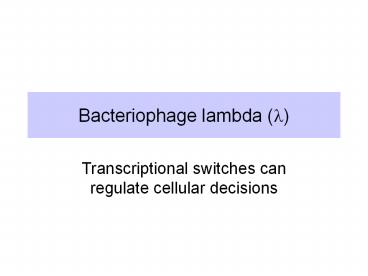Bacteriophage lambda (l) - PowerPoint PPT Presentation
Title:
Bacteriophage lambda (l)
Description:
Bacteriophage lambda (l) Transcriptional switches can regulate cellular decisions – PowerPoint PPT presentation
Number of Views:201
Avg rating:3.0/5.0
Title: Bacteriophage lambda (l)
1
Bacteriophage lambda (l)
- Transcriptional switches can regulate cellular
decisions
2
Lysis or Lysogeny
- Lysis Infection by phage produces many progeny
and breaks open (lyses) the host bacterium - Lysogeny After infection, the phage DNA
integrates into the host genome and resides there
passively - No progeny
- No lysis of the host
- Bacteriophage lambda can do either.
3
Infection by temperate phage leads to lysis or
lysogeny
4
Temperate and lytic phage have a different plaque
morphology
Lytic phage clear plaques
5
Elements of lysogeny
- The phage genome integrated into the host
bacterial genome is a prophage. - Bacterium carrying the prophage is a lysogen.
- Lysogens are immune to further infection by
similar phage because the phage functions are
repressed in trans. - Induction of the lysogen leads to excision of the
prophage, replication of the phage DNA, and lysis
of the host bacterium.
6
Induction and immunity of lysogens
l
7
Regulatory mutants of lambda
Clear plaque mutants
Need wild type for lysogeny
Establishment
Maintenance
cI
Yes
Yes
cII
Yes
No
cIII
Yes
No
Act in trans
Virulent mutants (vir)
Act in cis are double mutants in oR /or oL
8
Genes are clustered by function in the lambda
genome
Late control
Virus head tail
Recombination
Control region
Replication
Lysis
cos
origin
promoter
operator
terminator
Not to scale!
9
Immediate early transcription
Transcription by E. coli RNA polymerase initiates
at strong promoters PR , PR, and PL , and
terminates at ts.
6S RNA
10
Antitermination by N protein leads to early gene
expression
gam
int
red
att
xis
N
cI
cro
cII
O
P
Q
S
R
AJ
cIII
Pint
PL
PRM
PR
PRE
PR
tL1
tR1
tR2
t6S
tR3
6S RNA
N protein
Cro
CIII
CII
Q protein
Recombination proteins
Replication proteins
11
Lytic cascade Cro turns off cI, Q protein action
leads to late gene expression
Lytic functions
Replication proteins
Viral head tail proteins
12
Late stage of lytic cascade
High concentrations of Cro turn off PR and PL
. Abundant expression from PR.
Lytic functions
Viral head tail proteins
13
Lysogeny CII and CIII stimulate expression of cI
to make repressor
tint
PRE promoter for repression establishment
Repressor
14
Lysogeny Repressor turns off transcription
PRM promoter for repression maintenance
Repressor
Activated by Repressor binding to oR1 oR2
15
l operators overlap promoters
oR
oR1
oR2
oR3
PR
-10
-35
TTGACT
GATAAT
cro
N
ATAGAT 5
TTAGAT 5
-10
-35
PRM
16
Repressor structure
l repressor is a dimer monomer has 236 amino
acids.
l repressor can bind cooperatively to operator
sub-sites.
17
Lambda repressor bound to DNA via a
helix-turn-helix domain
http//www.rtc.riken.go.jp/jouhou/image/dna-protei
n/all/small_N1lli.gif
18
Cro structure
Cro is a dimer Monomer has 66 amino acids Has
only one protein domain Does NOT display
cooperativity
19
Competition between repressor and Cro for
operator sites
20
Use hybrid genes to dissect regulatory schemes
- Place a convenient reporter gene under control of
the regulatory elements being studied - Use a known regulatory region to control the
trans-acting regulatory element
21
l/lac hybrid genes
Place l cI gene under lac control.
Use lacZ as a reporter.
lac p, o
l cI
l pR , OR
lacZ
321
Control amount of l repressor by IPTG.
E. coli with lac repressor, no lacZ.
See effect of l repressor by b-galactosidase
activity
22
l repressor will turn off expression from PR PL
lac p, o
l cI
l pR , OR
lacZ
b-galactosidase
l repressor
IPTG
l repressor acts cooperatively.
23
Mutation of oR1 decreases affinity for l repressor
lac p, o
l cI
l pR , OR
lacZ
LOF mutation at oR1
b-galactosidase
l repressor
IPTG
24
Repressor will stimulate transcription from PRM
lac p, o
l cI
l pRM , OR
lacZ
123
b-galactosidase
l repressor
IPTG
l repressor at oR1 and oR2 stimulates
transcription from pRM.
25
Binding of repressor blocks transcription from pR
but activates pRM
PR
-10
-35
2 dimers of Repressor, bound cooperatively
oR3
RNA Pol
cro
N
oR1
oR2
-10
-35
operator
PRM
promoter
-10
-35
26
Two repressor dimers interacting cooperatively
via the C terminal domain
27
Bacteriophage l Events leading to lysis
- lysis or lysogeny (cI or Cro?) ?
- Both lysis and lysogeny
- PR, PL, PR active synthesize N, Cro
- antitermination by N synthesize cIII, cII, Q
- Lysis
- Low Cro binds OR3, shuts off PRM (cI)
- High Cro shuts off PR and PL
- antitermination by Q activation of PR by Cro
28
Bacteriophage l Events leading to lysogeny
- lysis or lysogeny (cI or Cro?) ?
- Lysis and lysogeny
- PR, PL, PR active synthesize N, Cro
- antitermination by N synthesize cIII, cII, Q
- Lysogeny
- cII stimulate expression from PRE (cI repressor)
and PINT (integrase) - cIII stabilizes cII
- cI repressor shuts off PR, PL, PR (no lytic
functions), stimulates PRM
29
Factors favoring lysogeny cause increased
concentrations of repressor vs. Cro
- High multiplicity of infection
- More templates produce more of the CII protein,
which stimulates PRE. - Phage sense that it is too crowded.
- Poor nutrient conditions for host
- Low glucose leads to increase in cAMP.
- Increased cAMP will repress the host gene hflA.
- Less HflA (a protease) leads to less degradation
of the CII protein.
30
Homework problems provide a quantitative approach
to the competition between Cro and repressor for
the l operators.

